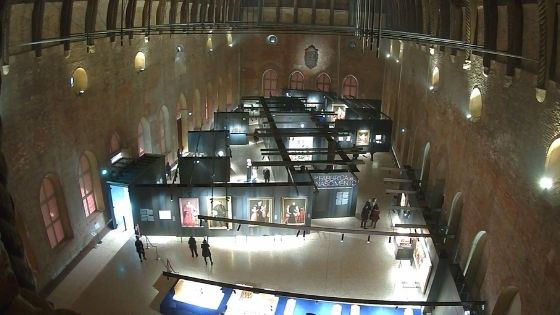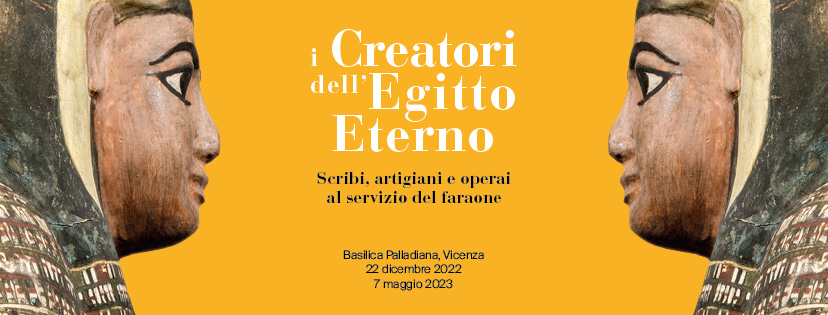The Creators of Eternal Egypt
Scribes, Artisans, and Laborers in the Service of the Pharaoh
Basilica Palladiana, Vicenza
22 December 2022 – 28 May 2023
Colossal statues, sumptuous tombs and ornate sarcophagi, bas-reliefs and painted stelae, papyrus scrolls and artifacts, all unearthed from the desert after millennia: this is where our idea of ancient Egypt comes from. The exhibition The Creators of Eternal Egypt. Scribes, Artisans, and Laborers in the Service of the Pharaoh recounts the genesis of this imagery through the material expressions of a complex and articulated world, from everyday tools to the pomp and sacred rites of the pharaohs.
The original exhibition itinerary, designed by the Egyptian Museum of Turin, takes visitors on a journey to discover the community of scribes, artisans and workers who built the tombs of the pharaohs in the Valley of the Kings. Over the centuries, the tombs have preserved the objects, memory, and splendor of this ancient civilization, whose fascination we still experience today. The exact location of the royal burials was secret, known only to the priests, to ensure the safekeeping the remains and great wealth of the rulers during their journey to the afterlife. For this reason, workers and their families lived isolated from the rest of society in a small village, now known as Deir el-Medina, nestled among the rocky hills not far from the royal necropolis on the opposite bank of the Nile from Thebes. It is to the ingenuity and labor of the inhabitants of Deir el-Medina that we owe much of our current understanding of ancient Egypt.
As part of the three-year project “Exhibitions in the Basilica”, The Creators of Eternal Egypt, which opens on 22 December at the Basilica Palladiana, follows the exhibition The Factory of the Renaissance. Creative Processes, Market, and Production in Vicenza, which delved into the ways that the artistic inventions and practices generated in Vicenza during the Renaissance influenced Western art history. Similarly, many of the images and ideas that have entered our collective imagination of ancient Egyptian art and culture were developed in Deir el-Medina.
Although far apart in space and time, both places were important centers of artistic and architectural production during two crucial periods of their history: the Renaissance in Italy and the New Kingdom in Egypt, which lasted nearly the entire second half of the second millennium BC.
In both cases, the successful combination of artistic sensibility and technical prowess grew out of tradition and gave rise to a period of great experimentation that shaped a new worldview and laid the foundation of our vision of the period. In this sense, the previous exhibition was the curators' starting point for the project of The Creators of Eternal Egypt, taking the opportunity to propose a parallel between the two situations and highlight, beyond the inevitable differences, the continuity represented by humankind’s desire to understand and represent the surrounding world through art, architecture, and artisanal virtuosity.
As such, the exhibition takes visitors on an imaginary journey from the Basilica Palladiana in downtown Vicenza to the monumental Thebes of 3,300 years ago, and then across the Nile to the small village of Deir el-Medina, to discover the city of the dead and the spectacular afterlife that awaited them, created by the patient and expert workmanship of those in the service of Pharaoh.
Structure of the exhibition
The itinerary unfolds inside the Basilica Palladiana among a wide selection of more than 150 artifacts from the Egyptian Museum in Turin and a group of about 20 works on loan from the Louvre Museum in Paris, ranging in scale from the smallest, most precious objects to sarcophagi and monumental statuary. A series of multimedia installations accompany the visitors' experience, breaking and expanding the boundaries of material culture: physically present objects are virtually ‘reinserted’ into their original historical context, now inevitably lost.
The exhibition is organized by interrelated themes. The evocative space beneath the vault of the Basilica is divided into two large sections: the first illustrating the everyday life and creation of these millennia-old masterpieces, and the second devoted to the life of the deceased after death.
The first stop on the journey is Thebes, the monumental city that spread along the east bank of the Nile, home of the great temples and capital of the New Kingdom for nearly three centuries. Here one encounters large sculptural groups of rulers and monumental statues of deities with attributes from the animal world.
While the eastern bank hosted the city of the living, the opposite bank, where the sun sets, housed the vast city of the dead: all the tombs and places of worship dedicated to the defunct and, above all, the great funerary temples of the pharaohs. The exhibition route then moves to the western shore and the humble village of Deir el-Medina, protected by the serpent goddess Meretseger and located at the foot of the great pyramidal mountain, in whose belly the tombs of the Valley of the Kings were excavated.
The exhibition offers a detailed account of the building of a pharaoh's tomb, whose long and demanding construction combined different skills and knowledge, from symbology to engineering, from theology to the logistical organization of labor. In addition to tools and implements, one can admire the papyri that conveyed the wisdom of these men through plans and descriptions of buildings and design studies.
This is followed by an in-depth look at the daily life of the laborers, artisans, and scribes who lived there, devoting themselves to the creation and preparation of the sumptuous tombs of the rulers. The scenes painted on the walls of the tombs and the artifacts unearthed are like the tiles of a complex mosaic, giving us insight into their way of life, which combined traditional arts handed down over the generations with colors, prayers and songs, as evidenced by the decorated stelae and ostraka (fragments of vases or stone chips), as well as some very rare musical instruments from both the Egyptian Museum and the Louvre. Other objects, such as the decoratively carved and painted wooden sedan chair, testify to the affluence and luxury in which some members of the Deir el-Medina community lived.
After exploring aspects of the earthly world, visitors are greeted by the sarcophagus of Khonsuirdis and cross the threshold into the second part of the exhibition, devoted to the journey of the deceased to the afterlife. Here they are led along a path that tells the story of the preparation of body and soul for eternal life, from the making of the splendid painted sarcophagi to the arrangement of the grave goods. A selection of objects from Queen Nefertari's rich burial trousseau is accompanied by fascinating turquoise faience objects, such as the Louvre bowl or Pharaoh Sethi I’s coterie of Ushabti, the little servants whose task it was to ease his labors in the afterlife. The itinerary leads to an artifact that, perhaps more than any other, inspires deep reflection on the dichotomy of life and death: the mummy and sarcophagus of Tariri.
As a final counterpoint, this material journey into the realm of the dead culminates in an immersive, immaterial experience that illustrates the burial of the scribe Butehamon and the deceased's final journey. Visitors walk through a videomapping installation built on a 3D-printed reproduction of the great sarcophagus, which reveals the secrets it contained and brings to life the human story behind this incredible find.
INFO AND BOOKING ONLINE: https://www.mostreinbasilica.it/en/egitto









